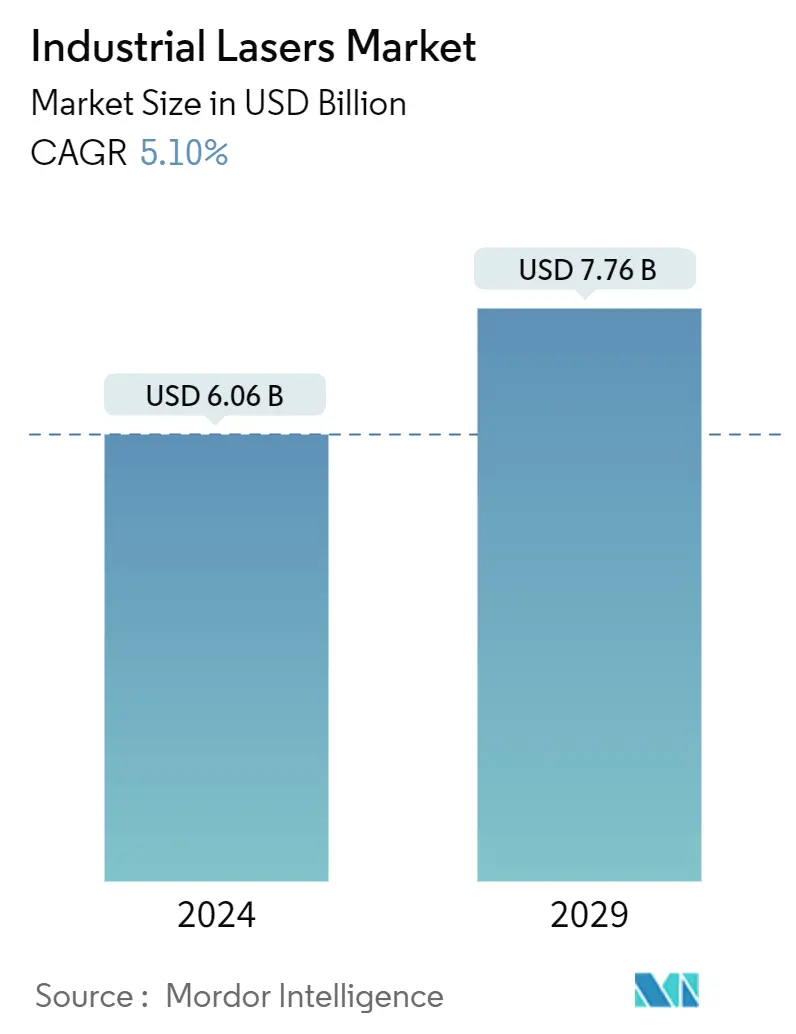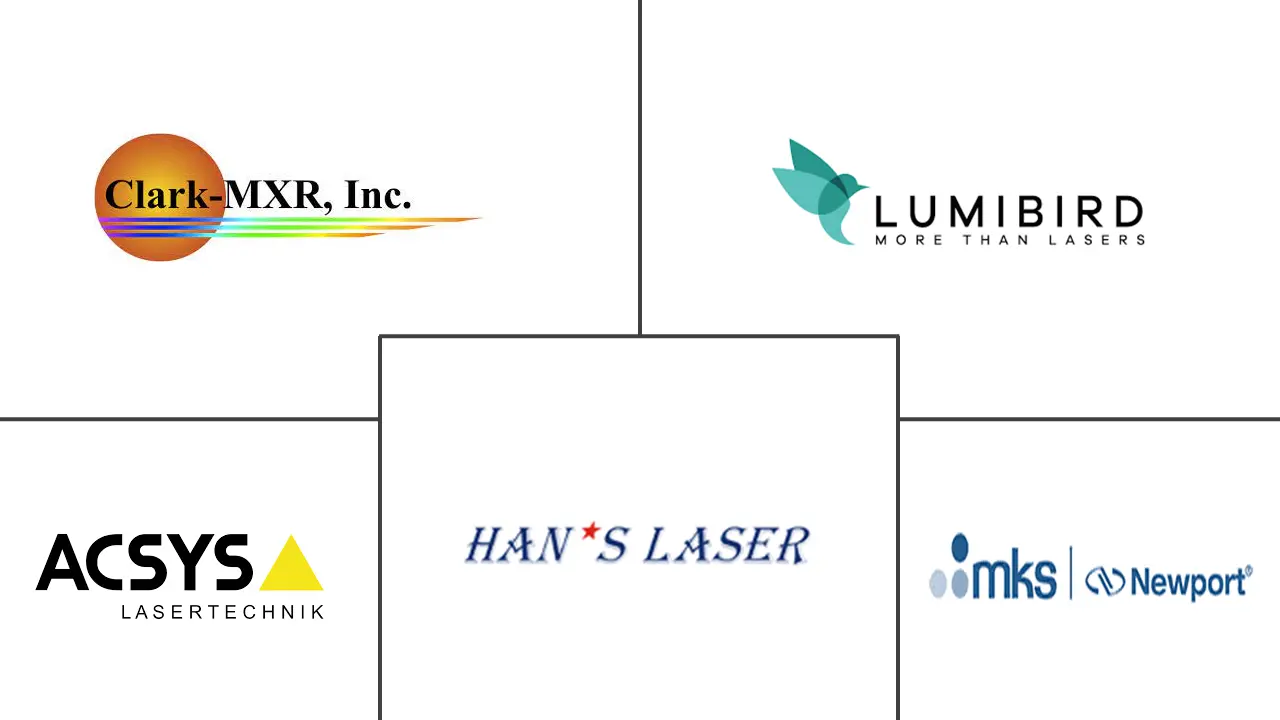Market Size of Industrial Lasers Industry

| Study Period | 2019-2029 |
| Market Size (2024) | USD 6.06 Billion |
| Market Size (2029) | USD 7.76 Billion |
| CAGR (2024 - 2029) | 5.10 % |
| Fastest Growing Market | Asia Pacific |
| Largest Market | Asia Pacific |
Major Players
*Disclaimer: Major Players sorted in no particular order |
Industrial Lasers Market Analysis
The Industrial Lasers Market size is estimated at USD 6.06 billion in 2024, and is expected to reach USD 7.76 billion by 2029, growing at a CAGR of 5.10% during the forecast period (2024-2029).
- The industrial lasers market is anticipated to witness robust growth during the forecast period owing to several factors, like rising demand for these lasers in medical and dental applications, space exploration, and industrial applications. Material processing is a prominent application for lasers in industries. Optical fiber lasers, followed by direct diode lasers, are majorly used for material processing.
- Industrial lasers are used in various biomedical instruments for medical imaging, laser surgery, and photodynamic therapy applications. They are commonly used in multiple soft tissue oral surgery, such as frenectomy, epulis fissuratum, fibroma removal, facial pigmentation treatment, and vascular lesion treatment. The diode laser’s ability to transmit energy to cells can be used for tasks like warming, welding, coagulation, protein denaturation, drying, vaporization, and carbonization.
- The market is witnessing various innovations and partnerships as vendors are looking to launch new solutions regularly for the aerospace and defense industry. For instance, in March 2022, Ultisense launched the LRF 6042, a 25 km rangefinder module with advanced fiber laser technology. The LRF 6042 is the newest addition to the Ultisense portfolio of high-performance fiber laser rangefinders and builds on Vectronix’s experience in developing military rangefinders. The compact LRF 6042 measures up to 8 km on 2.3 m × 2.3 m targets and boasts a maximum range performance of up to 25 km. Compared to other systems that have to charge and cool between pulses, the LRF 6042 measures continuously without interruption. It can achieve repetition rates of up to 10 Hz. This is ideal for tracking (e.g., people, vehicles) over an extended period.
- Enterprises adopting laser solutions as part of their manufacturing process are subject to various government safety regulations. In addition, the equipment is comparatively costlier than their conventional counterparts, thus challenging their adoption in the industrial space.
- Moreover, inflation significantly impacts manufacturing, leading to higher manufacturing costs. This can be due to various factors, such as higher prices for raw materials, increased shipping costs, and labor costs and shortages. As a result, manufacturers may be forced to raise their prices to maintain profitability, ultimately decreasing product demand. In addition, inflation can also lead to contract constraints, shifts in labor, and input issues for manufacturers. The rising inflation could restrain the growth of the market studied.
Industrial Lasers Industry Segmentation
Industrial lasers are used to cut metals and fabrics, mark tracking codes for industrial traceability, weld metals with high precision, clean metal surfaces, change the surface roughness, and measure part dimensions. Moreover, an industrial laser system comprises a laser source and embedded controls used as manufacturing tools in the industrial setting.
The industrial lasers market is segmented by type (fiber laser, solid-state laser, CO2 laser), application (cutting, welding, marking, drilling, additive manufacturing, and other applications), end-user industry (aerospace and defense, automotive, healthcare, consumer electronics, semiconductors, and other end-user industries) and geography (North America, Europe, Asia-Pacific, Latin America, Middle East and Africa). The market sizes and forecasts are provided in terms of value (USD) for all the above segments.
| By Type | |
| Fiber Laser | |
| Solid-state Laser | |
| CO2 Laser | |
| Other Types |
| By Application | |
| Cutting | |
| Welding | |
| Marking | |
| Drilling | |
| Additive Manufacturing | |
| Other Applications |
| By End-user Industry | |
| Aerospace and Defense | |
| Automotive | |
| Healthcare | |
| Consumer Electronics | |
| Semiconductors | |
| Other End-user Industries |
| By Geography | |
| North America | |
| Europe | |
| Asia-Pacific | |
| Latin America | |
| Middle East and Africa |
Industrial Lasers Market Size Summary
The industrial lasers market is poised for significant growth over the forecast period, driven by increasing demand across various sectors such as medical, dental, space exploration, and industrial applications. These lasers are integral to material processing, with optical fiber and direct diode lasers being the most utilized types. In the medical field, industrial lasers are employed in biomedical instruments for applications like laser surgery and medical imaging. The market is also experiencing a wave of innovations and strategic partnerships, particularly in the aerospace and defense sectors, as companies strive to introduce advanced laser solutions. However, the high cost of laser equipment compared to conventional alternatives and stringent government safety regulations pose challenges to widespread adoption in industrial settings.
The Asia-Pacific region is expected to lead the market's growth, supported by its robust manufacturing industries in automotive, electronics, aerospace, and medical devices. Countries like China, Japan, South Korea, and India are key players, with initiatives like India's 'Make in India' program boosting local manufacturing capabilities. The region's demand for industrial lasers is further fueled by the automotive industry's shift towards electrification and miniaturization, requiring high-precision laser applications. The market is semi-consolidated, with major vendors expanding their regional presence and exploring new applications for ultrafast lasers. Recent technological advancements and strategic partnerships, such as those by ACSYS Lasertechnik GmbH and IPG Photonics Corporation, highlight the ongoing innovation and collaboration within the industry.
Industrial Lasers Market Size - Table of Contents
-
1. MARKET INSIGHTS
-
1.1 Market Overview
-
1.2 Industry Value Chain Analysis
-
1.3 Industry Attractiveness - Porter's Five Forces Analysis
-
1.3.1 Bargaining Power of Suppliers
-
1.3.2 Bargaining Power of Buyers
-
1.3.3 Threat of New Entrants
-
1.3.4 Threat of Substitutes
-
1.3.5 Intensity of Competitive Rivalry
-
-
1.4 Impact of COVID-19 Aftereffects and Other Macroeconomic Factors on the Market
-
-
2. MARKET SEGMENTATION
-
2.1 By Type
-
2.1.1 Fiber Laser
-
2.1.2 Solid-state Laser
-
2.1.3 CO2 Laser
-
2.1.4 Other Types
-
-
2.2 By Application
-
2.2.1 Cutting
-
2.2.2 Welding
-
2.2.3 Marking
-
2.2.4 Drilling
-
2.2.5 Additive Manufacturing
-
2.2.6 Other Applications
-
-
2.3 By End-user Industry
-
2.3.1 Aerospace and Defense
-
2.3.2 Automotive
-
2.3.3 Healthcare
-
2.3.4 Consumer Electronics
-
2.3.5 Semiconductors
-
2.3.6 Other End-user Industries
-
-
2.4 By Geography
-
2.4.1 North America
-
2.4.2 Europe
-
2.4.3 Asia-Pacific
-
2.4.4 Latin America
-
2.4.5 Middle East and Africa
-
-
Industrial Lasers Market Size FAQs
How big is the Industrial Lasers Market?
The Industrial Lasers Market size is expected to reach USD 6.06 billion in 2024 and grow at a CAGR of 5.10% to reach USD 7.76 billion by 2029.
What is the current Industrial Lasers Market size?
In 2024, the Industrial Lasers Market size is expected to reach USD 6.06 billion.

